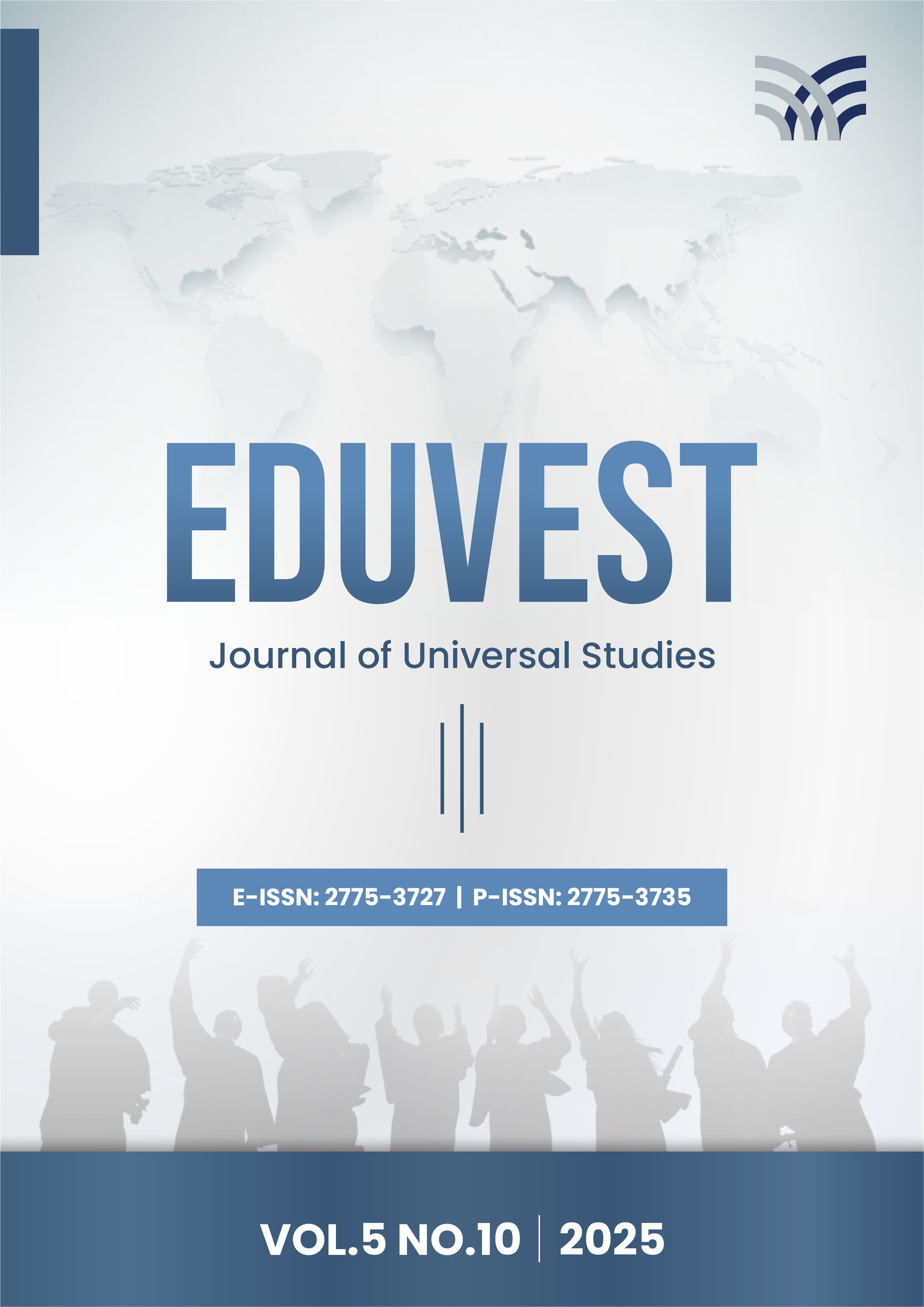Design of Green Marketing Strategy on XYZ Products with a SWOT Approach
DOI:
https://doi.org/10.59188/eduvest.v5i10.51284Keywords:
Green marketing, B2B, Marketing Mix, SWOTAbstract
The construction sector, as one of the largest contributors to global greenhouse gas emissions, faces major challenges in achieving sustainability. XYZ, a company known for industrial product innovation, is committed to developing an effective Design of Green Marketing Strategy on XYZ Products with a SWOT Approach to strengthen its environmentally friendly image. This study aims to examine how the marketing mix can be utilized while addressing competition and price wars in the industry. It also explores the role of sales, marketing, and customer service teams in communicating the company’s sustainability commitments to B2B consumers. Using a qualitative approach and strategic planning technique, this study seeks to understand how XYZ’s Design of Green Marketing Strategy on XYZ Products with a SWOT Approach is created and applied in a competitive B2B context. Data collection includes in-depth interviews with internal teams and analysis of relevant company marketing documents. The SWOT framework is used to evaluate the strategy’s strengths, weaknesses, opportunities, and threats. The findings are expected to offer practical insights into developing a green marketing strategy that effectively integrates People and Product. Additionally, this research provides recommendations for enhancing XYZ’s eco-friendly image and countering greenwashing practices. By addressing the integration of the marketing mix in industrial product contexts, this study contributes to the evolving body of green marketing literature.
References
Alwan, M. R. I., Ismiyah, E., & Negoro, Y. P. (2023). Anallisis Pengembangan Produk Minuman Sinom Menggunakan Matrik SWOT dan Metode QSPM.
Bonney, L., Beeler, L. L., Johnson, R. W., & Hochstein, B. (2022). The salesperson as a knowledge broker: The effect of sales influence tactics on customer learning, purchase decision, and profitability. Industrial Marketing Management, 104, 352–365. https://doi.org/10.1016/j.indmarman.2022.05.001
David, F. R., & David, F. (2017). Strategic management: Concepts and cases: a competitive advantage approach (Sixteenth edition, global edition). Pearson.
Ditahardiyani, P., Hartoni, H., & Aulia, R. (2023). Perumusan Strategi Pemasaran Hijau Kerajinan Rotan untuk Meningkatkan Kepuasan dan Loyalitas Konsumen. JIA (Jurnal Ilmiah Agribisnis) : Jurnal Agribisnis dan Ilmu Sosial Ekonomi Pertanian, 8(5), 362–373. https://doi.org/10.37149/jia.v8i5.825
Gelderman, C. J., Schijns, J., Lambrechts, W., & Vijgen, S. (2021). Green marketing as an environmental practice: The impact on green satisfaction and green loyalty in a business‐to‐business context. Business Strategy and the Environment, 30(4), 2061–2076. https://doi.org/10.1002/bse.2732
Gürel, E. (2017). Swot Analysis: A Theoretical Review. Journal of International Social Research, 10(51), 994–1006. https://doi.org/10.17719/jisr.2017.1832
Index Box Inc. (2022, December). Global Power Tool Market is Expected to Reach $43B by 2030 – IndexBox. Global Power Tool Market Is Expected to Reach $43B by 2030 – IndexBox. https://www.globenewswire.com/news-release/2022/12/16/2575319/0/en/Global-Power-Tool-Market-is-Expected-to-Reach-43B-by-2030-IndexBox.html#:~:text=Robert%20Bosch%20is%20the%20second,a%20market%20share%20of%208.1%25.
Jovičić, D., Ilić, D., & Raletić-Jotanović, S. (2022). Green marketing as a determinant of competitive advantages in B2B markets. International Journal of Economic Practice and Policy, 19(2), 76–98. https://doi.org/10.5937/skolbiz2-41068
Marc Lim, W. (2023). Transformative marketing in the new normal: A novel practice-scholarly integrative review of business-to-business marketing mix challenges, opportunities, and solutions. Journal of Business Research, 160, 113638. https://doi.org/10.1016/j.jbusres.2022.113638
Ma’ruf, A. (2022). Analisis strategi: Panduan praktis swot, GE – McKinsey, space, FFA, qspm, ahp menggunakan Microsoft Excel. Andi.
Münch, C., Benz, L. A., & Hartmann, E. (2022). Exploring the circular economy paradigm: A natural resource-based view on supplier selection criteria. Journal of Purchasing and Supply Management, 28(4), 100793. https://doi.org/10.1016/j.pursup.2022.100793
Rabbani, A. (2024, March). Power Tool Share in Indonesia [Personal Communication].
Sajid, Z. W., Aftab, U., & Ullah, F. (2024). Barriers to adopting circular procurement in the construction industry: The way forward. Sustainable Futures, 8, 100244. https://doi.org/10.1016/j.sftr.2024.100244
Susetyo, B. (2019). Tinjauan Kritis atas Konsep Konstruksi Berkelanjutan dengan Integrasi Metode Rekayasa Nilai dan Pengendalian Kualitas Pada Proyek Bangunan Gedung Bertingkat Tinggi.
Tzanidis, T., Magni, D., Scuotto, V., & Maalaoui, A. (2024). B2B green marketing strategies for European firms: Implications for people, planet and profit. Industrial Marketing Management, 117, 481–492. https://doi.org/10.1016/j.indmarman.2024.01.018
United Nations Environment Programme. (2023). Building Materials And The Climate: Status And Solutions. Nairobi.
Wurthmann, K. (2020). The essential mix: Six tools for strategy-making in the next decade. Journal of Business Strategy, 41(1), 38–49. https://doi.org/10.1108/JBS-09-2018-0147
Downloads
Published
How to Cite
Issue
Section
License
Copyright (c) 2025 Agra Gautama, Denpharanto Agung Krisprimandoyo, Fahrul Riza

This work is licensed under a Creative Commons Attribution-ShareAlike 4.0 International License.











